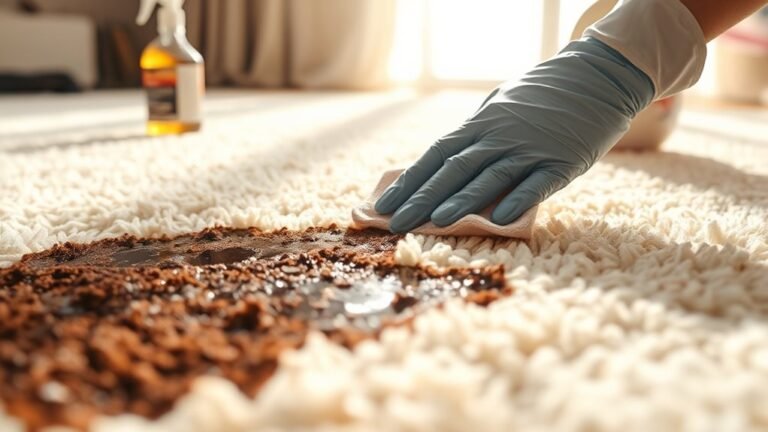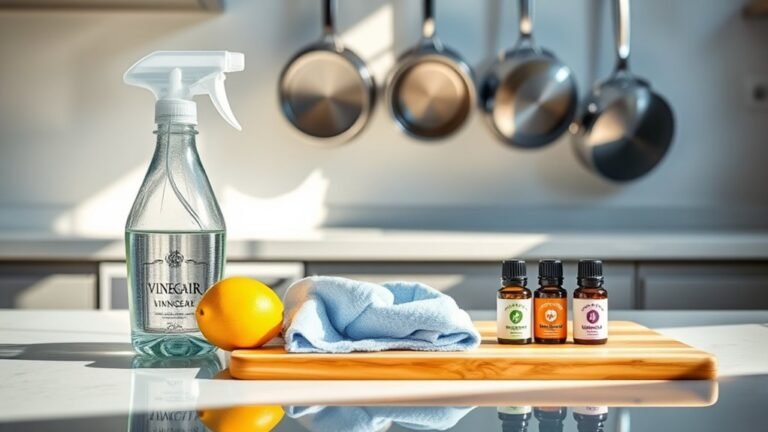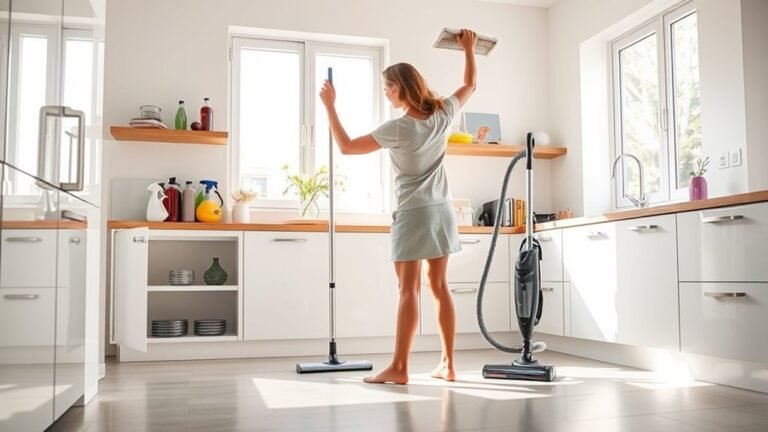Best Products to Clean Your Chair
To clean your chair effectively, choose products based on its material: use gentle, pH-balanced upholstery cleaners for fabric, pH-neutral leather cleaners for leather, and mild wood-specific solutions for wooden chairs. Natural options like vinegar and baking soda work well for general grime and odors without harsh chemicals. For stubborn stains, enzyme-based or oxygen bleach stain removers are ideal. Equip yourself with soft brushes and microfiber cloths for best results. Explore further to find tailored care tips that extend your chair’s life and appearance.
Top Fabric Upholstery Cleaners

Wondering which fabric upholstery cleaner will give your chairs a deep yet gentle clean? You’ll want products specifically designed for upholstery fabric care, which effectively lift dirt without damaging delicate fibers. Look for cleaners with biodegradable formulas that tackle stains and odors yet preserve your furniture’s texture and color. When cleaning fabric furniture, test the product on a hidden spot first to prevent discoloration. Spray lightly, then gently blot with a microfiber cloth to avoid overwetting. Avoid harsh chemicals that can weaken fabric or cause fading. Choosing the right upholstery cleaner allows you to maintain your chairs’ appearance while enjoying the freedom of a fresh, inviting space. Consistent, careful cleaning guarantees your fabric furniture stays comfortable and durable for years to come.
Effective Leather Cleaning Products
When caring for leather chairs, choosing the right cleaner is essential to maintain their look and durability. You’ll want to explore top leather cleaners that effectively remove dirt without damaging the material, along with natural solutions that offer gentle yet thorough cleaning. Don’t forget to condition and protect the leather afterward to keep it soft and prevent cracking over time.
Top Leather Cleaners
Although leather requires special care, choosing the right cleaner can make maintaining your furniture much easier. When you select a top leather cleaner, you’re not just removing dirt—you’re preserving the leather’s integrity and extending its life. To get the most from your cleaning routine, consider these essentials:
- pH-balanced formulas that protect natural oils and enhance leather conditioner benefits
- Products designed to complement leather repair techniques for addressing minor scratches or cracks
- Cleaners free from harsh chemicals, ensuring safe, effective cleaning without damaging the surface
Natural Cleaning Solutions
Since harsh chemicals can damage leather over time, opting for natural cleaning solutions is a smart choice for preserving your furniture’s appearance and durability. You’ll find plant based cleaners especially effective—they’re gentle yet efficient at removing dirt without stripping leather’s natural oils. Look for products containing ingredients like aloe vera or coconut oil, which hydrate while cleaning. Essential oil solutions, such as those with tea tree or lavender oil, not only disinfect but also impart a subtle, fresh scent. When using these natural options, always test on a small, hidden area first to verify compatibility. By choosing these eco-friendly alternatives, you maintain your chair’s integrity and enjoy peace of mind, knowing you’re avoiding harsh chemicals that can shorten your leather’s lifespan.
Conditioning and Protection Tips
To keep your leather chairs looking their best, you’ll need more than just cleaning—they require regular conditioning and protection to maintain their suppleness and prevent cracking. Effective chair maintenance includes applying a quality leather conditioner every 3-6 months to nourish the fibers and restore moisture. For upholstery protection, use a leather protectant spray that creates a barrier against spills and stains without compromising breathability. Here are three essential tips to help you:
- Choose conditioners with natural oils for deep hydration
- Test protection products on a hidden area before full application
- Avoid harsh chemicals that strip leather’s natural oils
Best Wooden Chair Cleaning Solutions
When you want to maintain the natural beauty of your wooden chairs, choosing the right cleaning solution is essential. Start with a gentle, pH-balanced cleaner specifically formulated for wood care to avoid stripping the finish or causing damage. Avoid harsh chemicals like ammonia or bleach, which can degrade the wood over time. Apply the cleaner with a soft cloth, following maintenance tips such as wiping in the grain’s direction and drying promptly to prevent moisture absorption. For stubborn dirt, use a mild soap diluted in water, but never soak the wood. Regular cleaning paired with proper wood care products will preserve your chair’s finish and structural integrity, giving you the freedom to enjoy its charm without constant worry about wear or discoloration.
Natural and Homemade Cleaning Options

You can easily freshen up your chairs using natural ingredients like vinegar and baking soda, which work together to break down grime and neutralize odors. Lemon juice solutions are also effective, especially for tackling stains and adding a subtle, clean scent. These homemade options are not only budget-friendly but also gentle on your furniture and the environment.
Vinegar and Baking Soda
Although commercial cleaners are widely available, vinegar and baking soda remain some of the most effective natural options for cleaning chairs. You’ll appreciate their versatility and safety compared to harsh chemicals. Vinegar benefits include its ability to break down grime and disinfect surfaces, while baking soda excels at deodorizing and gently scrubbing away stains.
Try these simple tips:
- Mix equal parts vinegar and water in a spray bottle for an all-purpose cleaner.
- Sprinkle baking soda on fabric chairs, let sit, then vacuum to remove odors.
- Combine baking soda and vinegar to tackle tough spots, allowing fizzing action to lift dirt.
Using these natural ingredients, you maintain freedom from toxins and keep your chair fresh and clean with minimal effort.
Lemon Juice Solutions
Three key benefits make lemon juice a standout natural cleaner for your chairs: its acidity cuts through grease and grime, its natural bleaching properties brighten fabrics, and its fresh scent leaves your space smelling clean without artificial chemicals. To harness lemon juice benefits effectively, mix equal parts lemon juice and water for a gentle spray that tackles stains and odors. For tougher spots, try a lemon juice recipe combining lemon juice, baking soda, and a few drops of mild dish soap to create a paste; apply it carefully, then rinse and air dry. Always spot test to avoid discoloration. Using these simple lemon juice recipes gives you freedom from harsh chemicals while maintaining your chair’s appearance, making lemon juice a smart, eco-friendly choice for natural chair cleaning.
Stain Removers for Tough Chair Spots
When tough stains settle into your chair’s fabric or upholstery, standard cleaning methods often won’t cut it. You need targeted stain removers designed for spot treatment that break down stubborn marks without harming the material. These products help you regain control and keep your chair looking fresh, while supporting stain prevention by treating spots quickly.
Consider these effective options:
- Enzyme-based stain removers: excellent for organic stains like food or sweat.
- Oxygen bleach powders: safe for colorfast fabrics and tough on dirt.
- Solvent-based spot cleaners: ideal for grease or ink, but test first on a hidden area.
Using the right remover promptly frees you from lingering spots and extends your chair’s lifespan, letting you enjoy a cleaner, more inviting space without hassle.
Eco-Friendly Chair Cleaning Products

Since you likely want a clean chair without exposing yourself or the environment to harsh chemicals, eco-friendly chair cleaning products offer a practical solution. These products prioritize biodegradable options that break down naturally, reducing pollution and waste. When selecting a cleaner, look for those made from sustainable materials like plant-based surfactants and natural oils, which effectively remove dirt without compromising fabric integrity. Using eco-friendly products supports a healthier indoor environment and aligns with your desire for freedom from toxic residues. They’re often safe for various chair fabrics, from leather to upholstery, providing versatility. By choosing these green alternatives, you maintain cleanliness while minimizing your ecological footprint—a smart, responsible choice for anyone valuing both comfort and sustainability in their home or workspace.
Tools and Accessories for Chair Maintenance
Although choosing the right cleaning products is essential, having the proper tools and accessories makes chair maintenance much more effective and efficient. The right cleaning tools help you tackle dirt and stains quickly, preserving your chair’s look and extending its life. To maintain your chairs freedom from grime and wear, consider these essentials:
- Soft-bristle brushes: Perfect for loosening dirt without damaging fabric or leather.
- Microfiber cloths: Ideal for gentle wiping and drying, preventing scratches.
- Portable vacuum with attachments: Great for removing debris from crevices and seams.
Using these tools alongside your cleaning products guarantees thorough chair maintenance. With the right accessories, you’ll enjoy hassle-free upkeep and keep your chairs looking fresh, letting you focus on what matters most—your freedom to relax comfortably.
Frequently Asked Questions
How Often Should I Deep Clean My Chair for Best Results?
Oh sure, you can deep clean your chair every day if you enjoy wasting time—because who doesn’t want a daily chair spa? Realistically, a deep cleaning frequency of every 3-6 months fits most lifestyles and maintains your chair’s look and comfort. Stick to a chair maintenance schedule that includes regular spot cleaning and vacuuming in between. This balance keeps your freedom intact without turning you into a chair-cleaning fanatic.
Can Cleaning Products Damage Delicate Chair Materials?
Yes, cleaning products can damage delicate chair materials if you’re not careful. When dealing with fabric care, always test a small, hidden area first to avoid discoloration or weakening fibers. Harsh chemicals might ruin your chair’s texture or color, so opt for gentle stain removal solutions designed for specific fabrics. This way, you protect your chair while keeping it fresh, giving you the freedom to enjoy both comfort and style without worry.
Are There Specific Cleaning Tips for Antique Chairs?
When caring for antique chairs, you’ll want to focus on gentle antique wood care and upholstery preservation. Avoid harsh chemicals; instead, use mild wood cleaners and soft cloths to protect the finish. For upholstery, vacuum regularly and spot-clean with fabric-safe solutions. Keep your chair out of direct sunlight to prevent fading and cracking. Taking these steps helps maintain its beauty and value without restricting how you enjoy your space.
How Do I Prevent Mold and Mildew on Chair Cushions?
Think of mold prevention as a shield you build for your cushions. To keep mildew away, make certain cushions stay dry—never let moisture linger. Regularly air them out in sunlight, which naturally kills mold spores. Use breathable fabric covers and consider a dehumidifier in damp rooms. Immediate spot cleaning with mild detergent helps, too. With consistent cushion care, you’re not just preventing mold—you’re preserving comfort and freedom in your space.
What Is the Best Way to Dry a Cleaned Chair Quickly?
To dry a cleaned chair quickly, you’ll want to maximize air circulation. Position a fan heater nearby but not too close to avoid damage; the warm airflow speeds up moisture evaporation. Open windows or doors to create cross-ventilation, letting fresh air move freely around the chair. This combination helps the fabric dry faster without lingering dampness, giving you the freedom to use your chair again sooner and preventing mold or mildew buildup.






